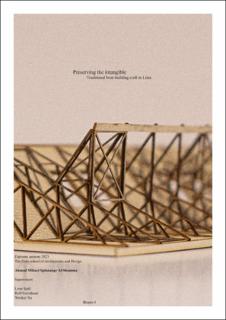| dc.contributor.advisor | Gerstlauer, Rolf | |
| dc.contributor.advisor | Sjøli, Lone | |
| dc.contributor.advisor | Xu, Wenkai | |
| dc.contributor.author | Al-Shamma, Ahmad Mikael Spinnangr | |
| dc.coverage.spatial | Borhaug, Lista, Farsund, Agder, Norway | en_US |
| dc.date.accessioned | 2024-02-28T09:20:43Z | |
| dc.date.available | 2024-02-28T09:20:43Z | |
| dc.date.issued | 2023-12 | |
| dc.identifier.uri | https://hdl.handle.net/11250/3120239 | |
| dc.description | This diploma works with the tradition of boat building and its craft in Borhaug; a small coastal village
in Farsund municipality. Boat-building has been an important cultural and economic activity in northern
Europe for a long time. Many Scandinavian boats share the same root. They are however all different.
Boat building is an activity that is always affected by its local context. The type of trees available, the intended use of the boat and cultural factors all play a role in the shaping of the boat. Boat traditions differ from region to region. Commonalties can always be found but each region develops the boat in a way that best suits its culture, economy, and resources. Borhaug is no exception to this. In 1815 Gjert Gundersen came to Lista as a merchant but then settled in as a boat builder. He brought with him the boat building tradition from Hardanger. He observed the eastern boats in Lista as there were no boats being built in Lista at that time. He then combined the eastern and western boat into what now is know as the Lista boat.
Ole Olsen Stave, a local, took what Gundersen had and developed it further. He was the first to put a deck on a Lista boat. His contribution goes beyond that as he gave that tradition further to his apprentices that carried on the work after his death. In the second half of the 19th century the Lista boat started to get more attention and demand from regions in the south. The production of these boats became an important economic activity. Many families started building boats and use them to fish. The boats were also used in races and shows where the Lista boat won different competitions increasing the demand even more. The boat was known to require less ballast thus making it attractive for fishermen. Borhaug became a center for all the fishermen to fish and to fix and build boats.
When the fishing industry started to take a downturn the Lista boat was being used for transportation of goods. It also proved to be successful in that regard.
The lista boat struggled to compete against industrial boats. Adaptations were made to the wooden boats but the local industry could not keep up with the rapid industrialization of boat making centers. More and more boat workshops started closing with the last one closing being Brekneholmen boat workshop that was converted in 2003 into a cultural center. The research in this diploma is concerned with boat building as a craft. The research is thereafter used to develop an architectural proposal for preserving the boat and its craft. The proposal takes place in the harbor area of the cultural center. It reverts it back to its original function where it will be used as a
small boat workshop. The program is also extended with a slipway in order to provide a space for the larger Lista boats | en_US |
| dc.language.iso | eng | en_US |
| dc.publisher | The Oslo School of Architecture and Design | en_US |
| dc.subject | Architecture | en_US |
| dc.subject | Arkitektur | en_US |
| dc.subject | Båtbyggeri | en_US |
| dc.subject | Tradisjonshåndverk | en_US |
| dc.subject | Trebåter | en_US |
| dc.subject | Båter | en_US |
| dc.title | Preserving the intangible Traditional boat-building craft in Lista | en_US |
| dc.type | Master thesis | en_US |
| dc.description.version | submittedVersion | en_US |
| dc.rights.holder | Ahmad Mikael Spinnangr Al-Shamma | en_US |
| dc.subject.nsi | VDP::Humanities: 000::Architecture and design: 140 | en_US |

